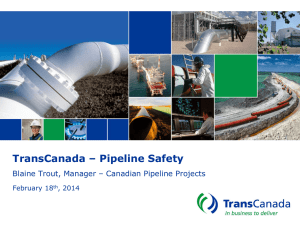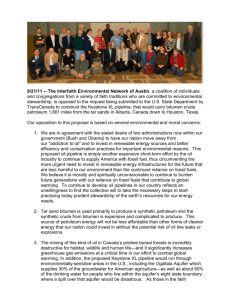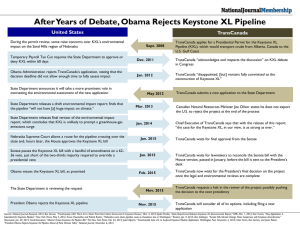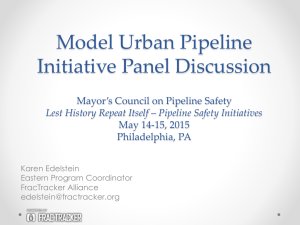TransCanada in Mexico
advertisement
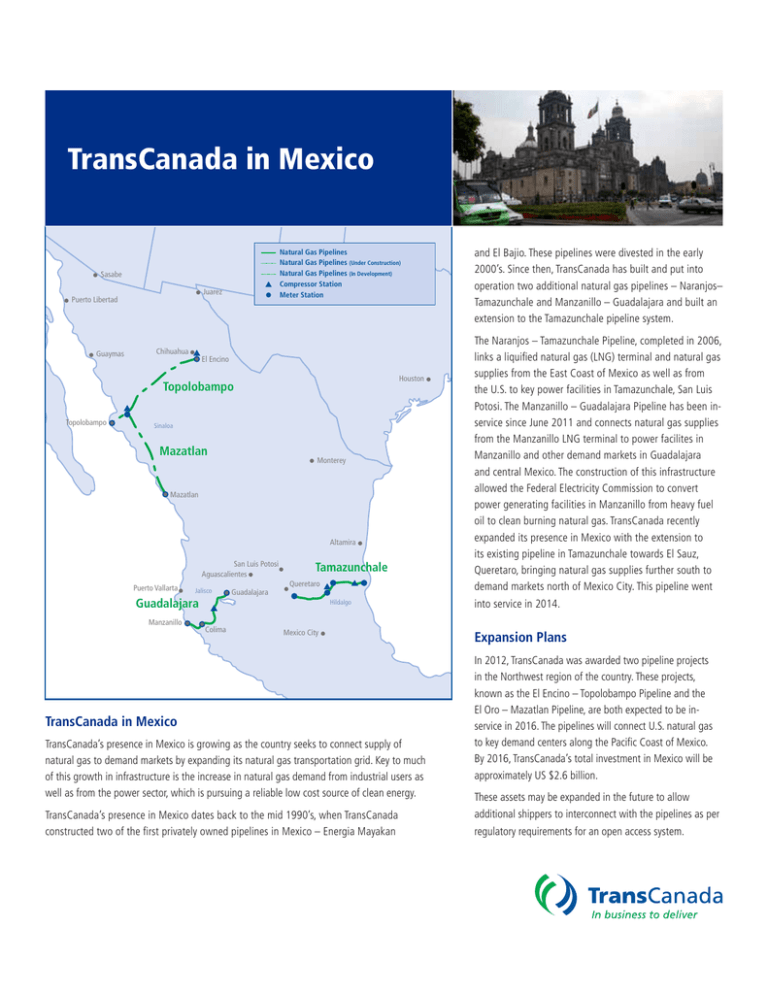
TransCanada in Mexico Natural Gas Pipelines Natural Gas Pipelines (Under Construction) Natural Gas Pipelines (In Development) Compressor Station Meter Station Sasabe Juarez Puerto Libertad Guaymas Chihuahua El Encino Houston Topolobampo Topolobampo Sinaloa Mazatlan Monterey Mazatlan Altamira San Luis Potosi Aguascalientes Puerto Vallarta Jalisco Guadalajara Manzanillo Guadalajara Tamazunchale Queretaro Hildalgo and El Bajio. These pipelines were divested in the early 2000’s. Since then, TransCanada has built and put into operation two additional natural gas pipelines – Naranjos– Tamazunchale and Manzanillo – Guadalajara and built an extension to the Tamazunchale pipeline system. The Naranjos – Tamazunchale Pipeline, completed in 2006, links a liquified natural gas (LNG) terminal and natural gas supplies from the East Coast of Mexico as well as from the U.S. to key power facilities in Tamazunchale, San Luis Potosi. The Manzanillo – Guadalajara Pipeline has been inservice since June 2011 and connects natural gas supplies from the Manzanillo LNG terminal to power facilites in Manzanillo and other demand markets in Guadalajara and central Mexico. The construction of this infrastructure allowed the Federal Electricity Commission to convert power generating facilities in Manzanillo from heavy fuel oil to clean burning natural gas. TransCanada recently expanded its presence in Mexico with the extension to its existing pipeline in Tamazunchale towards El Sauz, Queretaro, bringing natural gas supplies further south to demand markets north of Mexico City. This pipeline went into service in 2014. Cancun Valladolid Colima Mexico City TransCanada in Mexico TransCanada’s presence in Mexico is growing as the country seeks to connect supply of natural gas to demand markets by expanding its natural gas transportation grid. Key to much of this growth in infrastructure is the increase in natural gas demand from industrial users as well as from the power sector, which is pursuing a reliable low cost source of clean energy. TransCanada’s presence in Mexico dates back to the mid 1990’s, when TransCanada constructed two of the first privately owned pipelines in Mexico – Energia Mayakan Expansion Plans In 2012, TransCanada was awarded two pipeline projects in the Northwest region of the country. These projects, known as the El Encino – Topolobampo Pipeline and the El Oro – Mazatlan Pipeline, are both expected to be inservice in 2016. The pipelines will connect U.S. natural gas to key demand centers along the Pacific Coast of Mexico. By 2016, TransCanada’s total investment in Mexico will be approximately US $2.6 billion. These assets may be expanded in the future to allow additional shippers to interconnect with the pipelines as per regulatory requirements for an open access system. Working Together TransCanada – Who We Are All of TransCanada’s pipelines in Mexico are regulated by the Mexican pipeline regulator, the TransCanada’s mission is to provide reliable supplies of Comision Reguladora de Energia (CRE). The CRE ensures that the pipelines are designed, built energy across the continent, safely and responsibly. We and operated in accordance with Mexican laws and regulations and capacity requirements of are proud that millions of people can depend on us for the firm contracts. TransCanada’s standards either meet or exceed these requirements. energy they need each day. At peak construction, the Manzanillo – Guadalajara Pipeline project employed approximately We’re there every day delivering and, in some cases, 1,600 people, and almost half of the pipe was manufactured in Mexico. More than 2,000 generating, the energy that’s so essential to heat homes, residents in Mexico were employed during construction of the Tamazunchale Pipeline fuel businesses, and keep the lights on. While the name Extension. Additionally, over 50 percent of the pipe sourced for this project was manufactured is TransCanada, the company spans the continent. With in Mexico. headquarters in Calgary, Canada, TransCanada also has a TransCanada has a strong track record of working with industry customers in Mexico. Our significant presence in the United States and continuing expertise in constructing large infrastructure energy projects and operating safe, reliable, natural gas pipelines positions us well to continue to support Mexico in meeting its growing growth in Mexico. TransCanada has approximately 5,000 dedicated employees across North America. demand of natural gas. Our Current Assets and Projects in Mexico Natural Gas Pipeline Investment Length (KM) Contracted Capacity (Mmcf/d) Status ($US in millions) 265 130 8251 Pipeline has been operational since December 2006. Naranjos compression station expected to be in-service late 2014. Manzanillo – Guadalajara 435 310 500/3202 Pipeline has been operational since June 2011. Tuxpan permanent compression station in-service January 2013. Tamazunchale – El Sauz 600 235 630 Pipeline has been operational since November 2014. El Oro – Mazatlan 400 413 200 Bid awarded in 2012. Expected to be in-service late 2016. El Encino – Topolobampo 1,000 530 670 Bid awarded in 2012. Expected to be in-service mid 2016. Totals 1,618 2,645 Naranjos – Tamazunchale 2,700 Notes 1. Pipeline with compression. 2. The Guadalajara Pipeline has contracted capacity to transport 500 Mmcf/d to a nearby power plant owned by Comisión Federal de Electricidad (CFE) and 320 Mmcf/d to the National Pipeline System owned by Petróleos Mexicanos (Pemex). Wholly Owned Natural Gas Pipeline Partially Owned Natural Gas Pipeline Our Expertise Natural Gas Pipeline Under Construction Keeping our assets running safely and efficiently is a Natural Gas Pipeline In Development daily focus, and TransCanada has an outstanding track Natural Gas Pipeline Proposed record. TransCanada designs, constructs and operates Oil Pipeline Oil Pipeline Under Construction its facilities in compliance with all applicable laws and Oil Pipeline In Development regulations to minimize risks to employees, the public Power Facility and the environment. Gas Storage With more than 60 years’ experience, TransCanada is a leader in the responsible development and reliable operation of North American energy infrastructure including natural gas and oil pipelines, power generation and gas storage facilities. TransCanada operates a network of natural gas pipelines that extends more than 68,500 kilometers, tapping into virtually all major gas supply basins in North America. It transports approximately 20 per cent of the natural gas consumed in North America, an average daily volume of approximately 14 Bcf. TransCanada is also one of the continent’s largest providers of gas storage and related services with more than 400 billion cubic feet of storage capacity. A growing independent power producer, TransCanada owns or has interests in approximately 11,800 megawatts of power generation in Canada and the United States. TransCanada is developing one of North America’s largest oil delivery systems. TransCanada’s common shares trade on the Toronto and New York stock exchanges under the symbol TRP. Financial Highlights Year ending December 31st, 2013 (Financial figures in Canadian dollars) • Total Assets: $38 billion • Net income for 2013 of $1.6 billion • Funds generated from operations of $4 billion Safety is a top priority TransCanada’s Experience • TransCanada uses high-quality steel and best construction practices when building pipelines. TransCanada also has a track record in Latin America • All pipes are pressure-tested to well above-normal operating pressure before being put into service. going back to the late 1990s – having built and operated a number of natural gas pipelines, including Gas Andes in Argentina and Chile and TransGas • Pipelines are monitored 24 hours a day by trained operators who respond immediately to any indication of abnormal operation. in Colombia and Peru. These assets were sold by • The pipelines are cathodically protected, which means a low-voltage electric current is induced near the pipeline to inhibit external corrosion. however, they remain part of our proud history of • TransCanada’s pipelines are regularly inspected from the air, from the ground and internally, through a process known as pigging. • Public awareness campaigns ensure that neighbors and first responders understand TransCanada’s operations and know what to do in case of an emergency. www.transcanada.com November 2014 TransCanada as part of restructuring in the early 2000s, industry-leading pipeline construction and operation.
